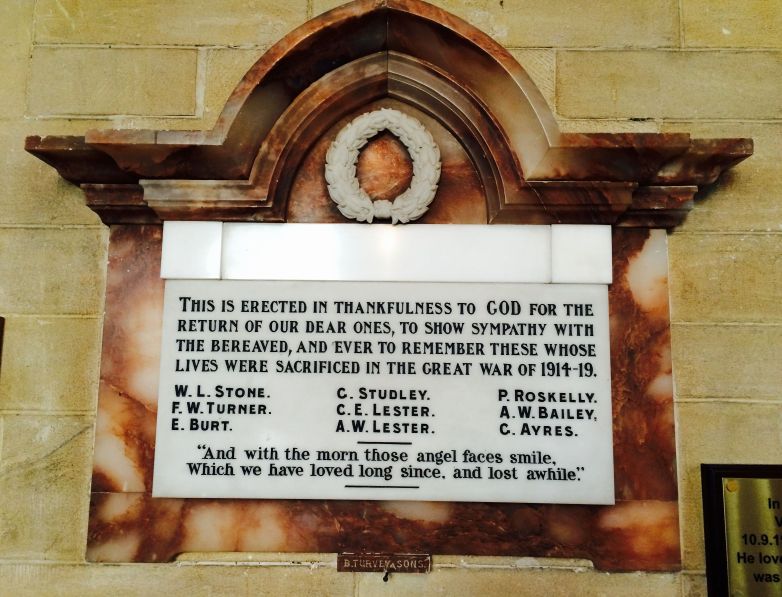Oldfield Park Junior School (Bath) WW1 Memorial Project
Beechen Cliff Methodist Church (Bath)
WW1 Memorial

From the Bath Chronicle and Weekly Gazette, Saturday 24th July 1920
BEECHEN CLIFF METHODISTS
Unveiling of a War Memorial
Mr. G. K. Turvey’s Thankoffering
There was a good congregation at Beechen Cliff Methodist
Church on Sunday morning when the unveiling of a memorial to those connected
with the Church who had fallen in the Great War took place. The memorial was
suitably inscribed and was in the form of a marble and alabaster tablet, kindly
presented to the church by Mr. G. K. Turvey as a thank-offering for the safe
return of his only son. It is fixed at the eastern end of the building on the
opposite side to the pulpit and bears the names of nine young men.
THE UNVEILING
Mr. G. K. Turvey performed the ceremony of unveiling and
handed over the memorial as a gift to the Church to the Pastor (Rev. R. Wilton)
who accepted it on behalf of the Trustees of the building. Mr. Turvey said the
tablet was to be regarded as a memorial to those young men connected with the
Church who had laid down their lives for their country. He concluded his
remarks by quoting the following lines from a poem by John Oxenham:
For our short sight to understand:
We catch but broken strokes and try
To fathom all the mystery
Of withered hopes, of death , of life,
The endless war, the useless strife.
But there, with larger, clearer sight
We shall see this: His way was right."
The Rev. R. Wilton, in accepting the gift, said the tablet
would remain as a sign of willing sacrifice for generations to come, and would
be a reminder to their children and their children’s children of the Great War
and of their thank-offering to God for the return of their loved ones. It was a
memorial to their heroic brothers connected more or less with that Church and
congregation, who had made the supreme sacrifice for their country. They owed
to them a great debt which could never be repaid, for they had given their all,
in the sacred cause of liberty. They left them to the Heavenly father in faith
and confidence of a happy re-union. One of the best ways to remember them was
to make this country worthy of their sacrifice and worthy of its best
traditions. They all wanted England to be great, glorious and free; “First
flower of the earth, first gem of the sea.”
The choir sang the anthem “What are these arrayed in white
robes”. Afterwards the tablet which was executed and fixed by Messrs. B. Turvey
& Sons was viewed and much admired. Captain Stone was present with a
company of Girl Guides and Scoutmaster O’Hara with a troop of Boy Scouts.
The inscription on the memorial reads:
return of our dear ones, to show sympathy with
the bereaved, and ever to remember those whose
lives were sacrificed in the Great War of 1914-19
| W. L. Stone F. W. Turner E. Burt | C. Studley C. E. Lester A. W. Lester | P. Roskelly A. W. Bailey C. Ayres |
"And with the morn, those angel faces smile
Which we have loved long since, and lost awhile"